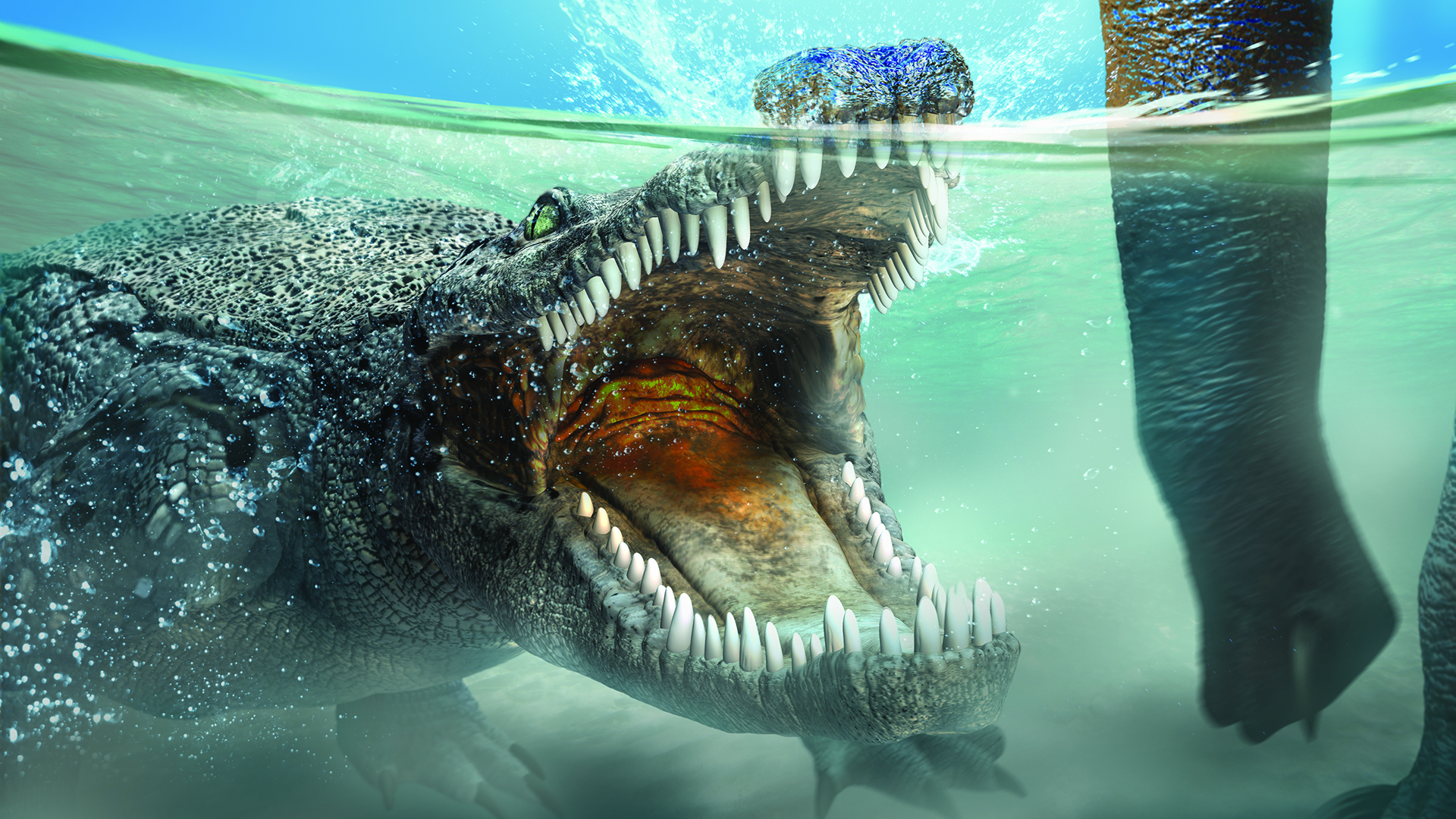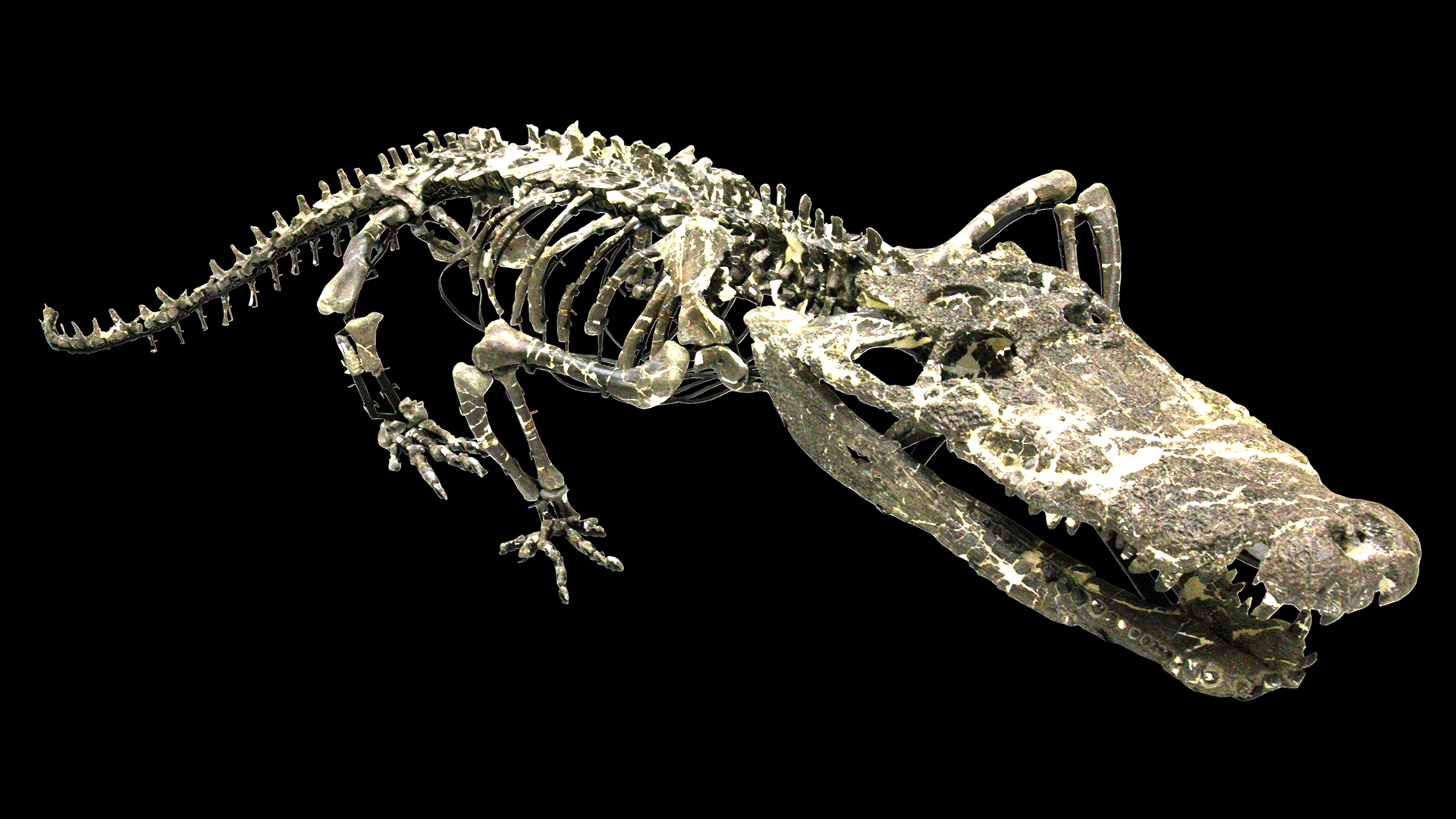Jurassic crocodile relative could breathe easily while drowning its prey
This is the earliest evidence of an airway adaptation found in modern crocodilians.

Around 155 million years ago in what is now Wyoming, a crocodile relative clamped its jaws around a thrashing animal and dragged it below the water's surface, and the ancient reptile could still breathe comfortably as its prey slowly drowned.
That's because the croc had specialized structures that prevented water from flowing through its mouth and into its airway. This feature is known in modern crocodilians — crocodiles and their close relatives — and scientists recently identified the same mechanism in a newly described species of croc cousin that lived during the Jurassic period (201.3 million to 145 million years ago).
This is the earliest evidence of crocodilian adaptations for submerging their heads (and prey) underwater while still being able to breathe through nostrils on top of their snouts; this ability is an important part of the group's deadly feeding habits today, and may have helped crocodilians survive the Cretaceous extinction that wiped out most of the dinosaurs.
Related: Crocs: Ancient predators in a modern world (photos)
Scientists named the newfound species Amphicotylus milesi, and it belongs to a group of early crocodile relatives called goniopholidids, which lived in the Northern Hemisphere from the Jurassic through the early Cretaceous period (145 million to 66 million years ago) and had a body plan suggestive of a semiaquatic lifestyle.
The near-intact skeleton, discovered in 1993 in Wyoming's East Camarasaurus Quarry, is the most complete goniopholidid fossil ever found. When it was alive, the reptile would have measured about 7.5 feet (2.3 meters) long and weighed up to 500 pounds (227 kilograms), study co-author Michael J. Ryan, an adjunct research professor in the Department of Earth Sciences at Carleton University in Ontario, told Live Science in an email.
A. milesi also has one of the biggest known skulls among this group of early crocs, measuring 17 inches (43 centimeters) long, and the broad, elongated snout accounts for about 60% of the skull length, the scientists reported Dec. 8 in the journal Royal Society Open Science. However, unfused sutures in some of the bones hint that the reptile was a youngster that was still growing, according to the study.
Get the world’s most fascinating discoveries delivered straight to your inbox.
"I believe that it was approximately adult size, but reptiles like this would have had indeterminate growth — continuing to grow through their lives, but slowing down after maturity," Ryan said. "A conservative estimate would be that an 'adult' could have been half again as long and heavy," measuring nearly 12 feet long (3.7 m) and weighing up to 750 pounds (340 kg), he added.
Breathe deep
Modern crocodilians — crocodiles, alligators, caimans and gharials — can breathe through their mouths and through nostrils on top of their snouts. The nostrils have protective valves at the openings, and air travels through canals and down the back of the throat, where it passes through another valve, according to the IUCN-Species Survival Commission's Crocodile Specialist Group (CSG), a global network of experts involved in crocodilian conservation.
When a crocodilian basks on land, it typically breathes through its open mouth, and the palatal valve in the throat (also known as a gular flap) is open. However, when it is holding prey in the water, the crocodilian breathes through its nostrils and the flap is closed, which prevents the animal from inhaling water through its open mouth, according to the CSG. When this flap isn't in use, it rests in the underside of the throat, and a network of muscles lifts the flap into place to block the flow of water.
Related: Photos: Early dinosaur cousin looked like a croc
As the researchers examined the size, shape and curvature of skull structures in A. milesi, they found similarities to certain features in modern crocodiles with the gular flap, such as an extension in the roof of the mouth toward the back of the throat and a shortened bone called the ceratobranchial, which lies in the throat and supports the tongue. This combination of anatomical features in A. milesi suggests that this ancient croc relative also had a flap that would have kept it from inhaling water while drowning its prey, so long as it kept its nostrils above the water, the study authors reported.
Other crocodilian relatives dating to the late Jurassic and early Cretaceous periods have similar modifications, "suggesting that they, too, may have had a similar ability," Ryan said. "But this combination of anatomical features is unique to Amphicotylus."
Adaptations for underwater dining could help to explain why the ancestors of modern crocodiles were able to weather the mass extinction event at the end of the Cretaceous period while their nonavian dinosaur contemporaries died out, Ryan explained.
"The features now recognized in Amphicotylus allowing for a feeding strategy that nonavian dinosaurs did not have might have contributed to their survival of the Cretaceous extinction — by staying and feeding in the water," Ryan said.
Originally published on Live Science

Mindy Weisberger is a science journalist and author of "Rise of the Zombie Bugs: The Surprising Science of Parasitic Mind-Control" (Hopkins Press). She formerly edited for Scholastic and was a channel editor and senior writer for Live Science. She has reported on general science, covering climate change, paleontology, biology and space. Mindy studied film at Columbia University; prior to LS, she produced, wrote and directed media for the American Museum of Natural History in NYC. Her videos about dinosaurs, astrophysics, biodiversity and evolution appear in museums and science centers worldwide, earning awards such as the CINE Golden Eagle and the Communicator Award of Excellence. Her writing has also appeared in Scientific American, The Washington Post, How It Works Magazine and CNN.



